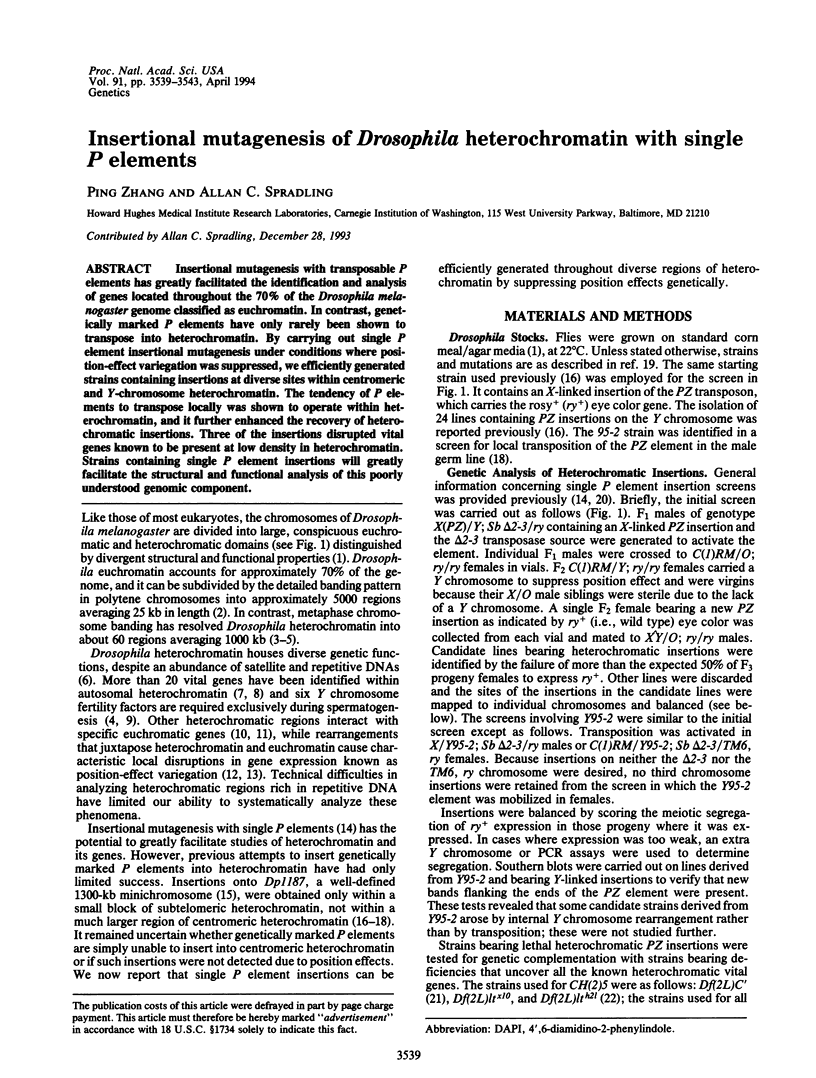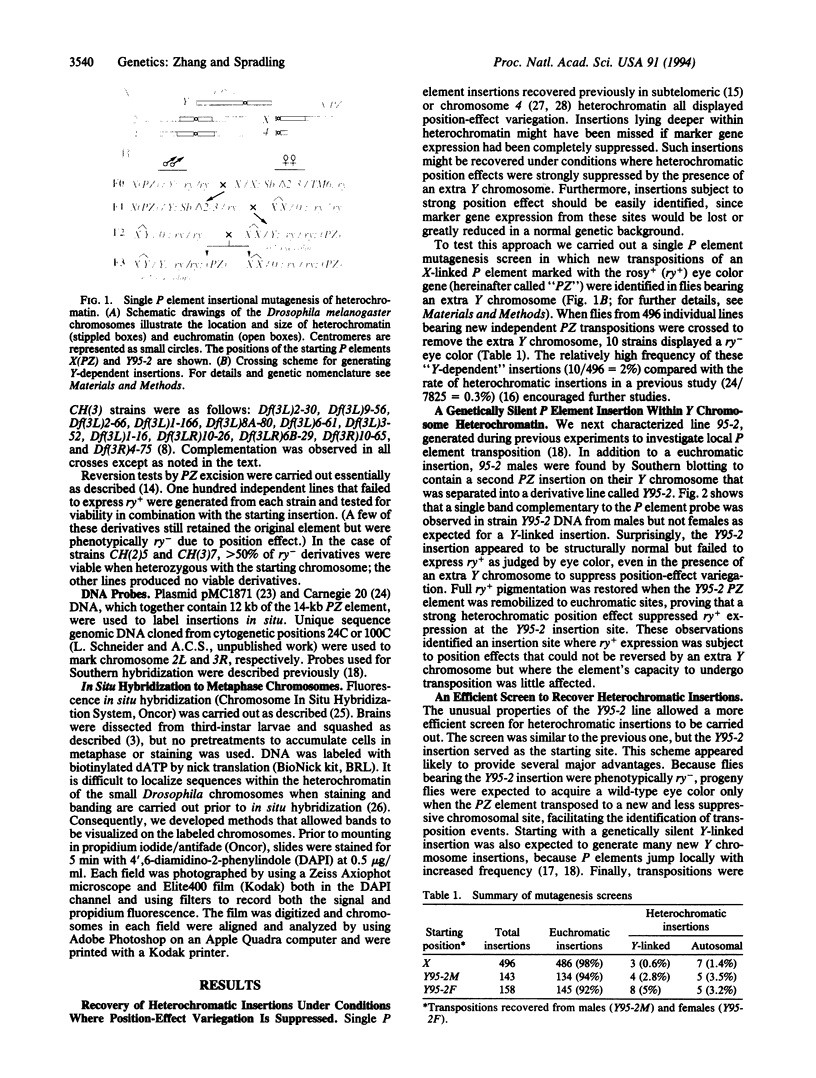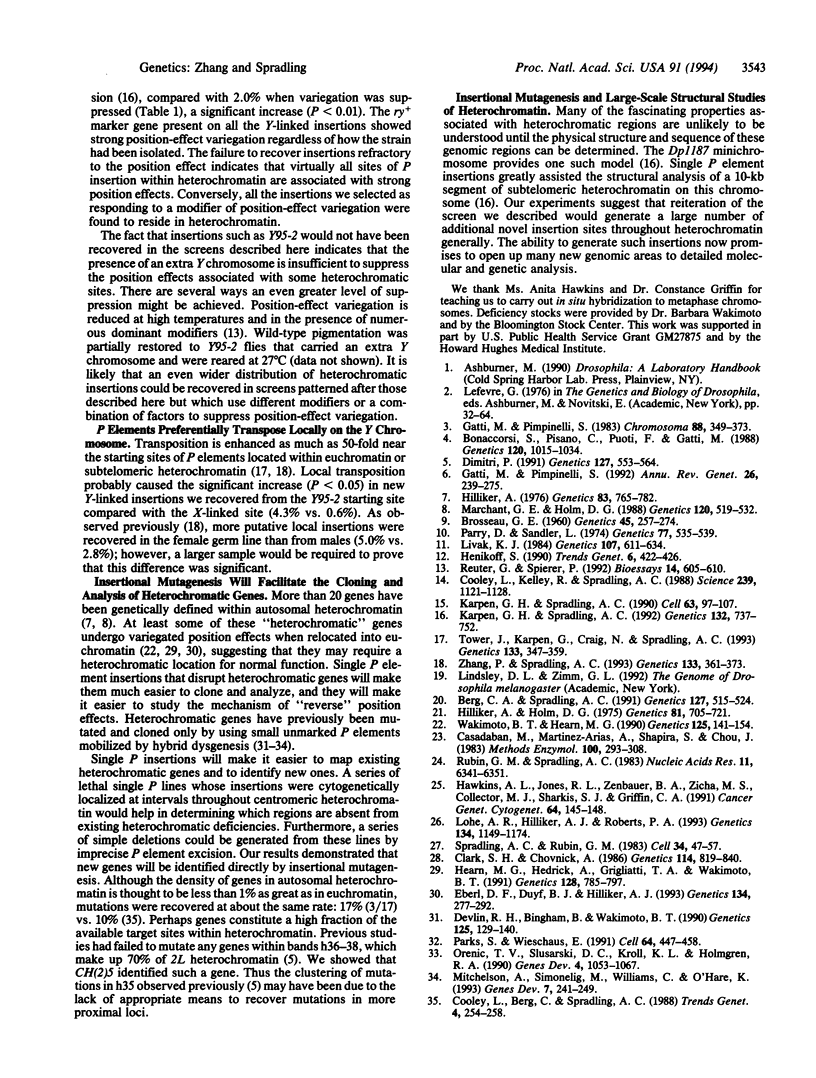Abstract
Insertional mutagenesis with transposable P elements has greatly facilitated the identification and analysis of genes located throughout the 70% of the Drosophila melanogaster genome classified as euchromatin. In contrast, genetically marked P elements have only rarely been shown to transpose into heterochromatin. By carrying out single P element insertional mutagenesis under conditions where position-effect variegation was suppressed, we efficiently generated strains containing insertions at diverse sites within centromeric and Y-chromosome heterochromatin. The tendency of P elements to transpose locally was shown to operate within heterochromatin, and it further enhanced the recovery of heterochromatic insertions. Three of the insertions disrupted vital genes known to be present at low density in heterochromatin. Strains containing single P element insertions will greatly facilitate the structural and functional analysis of this poorly understood genomic component.
Full text
PDF




Images in this article
Selected References
These references are in PubMed. This may not be the complete list of references from this article.
- Berg C. A., Spradling A. C. Studies on the rate and site-specificity of P element transposition. Genetics. 1991 Mar;127(3):515–524. doi: 10.1093/genetics/127.3.515. [DOI] [PMC free article] [PubMed] [Google Scholar]
- Bonaccorsi S., Pisano C., Puoti F., Gatti M. Y chromosome loops in Drosophila melanogaster. Genetics. 1988 Dec;120(4):1015–1034. doi: 10.1093/genetics/120.4.1015. [DOI] [PMC free article] [PubMed] [Google Scholar]
- Brosseau G E. Genetic Analysis of the Male Fertility Factors on the Y Chromosome of Drosophila Melanogaster. Genetics. 1960 Mar;45(3):257–274. doi: 10.1093/genetics/45.3.257. [DOI] [PMC free article] [PubMed] [Google Scholar]
- Casadaban M. J., Martinez-Arias A., Shapira S. K., Chou J. Beta-galactosidase gene fusions for analyzing gene expression in escherichia coli and yeast. Methods Enzymol. 1983;100:293–308. doi: 10.1016/0076-6879(83)00063-4. [DOI] [PubMed] [Google Scholar]
- Clark S. H., Chovnick A. Studies of normal and position-affected expression of rosy region genes in Drosophila melanogaster. Genetics. 1986 Nov;114(3):819–840. doi: 10.1093/genetics/114.3.819. [DOI] [PMC free article] [PubMed] [Google Scholar]
- Cooley L., Berg C., Spradling A. Controlling P element insertional mutagenesis. Trends Genet. 1988 Sep;4(9):254–258. doi: 10.1016/0168-9525(88)90032-7. [DOI] [PubMed] [Google Scholar]
- Cooley L., Kelley R., Spradling A. Insertional mutagenesis of the Drosophila genome with single P elements. Science. 1988 Mar 4;239(4844):1121–1128. doi: 10.1126/science.2830671. [DOI] [PubMed] [Google Scholar]
- Devlin R. H., Bingham B., Wakimoto B. T. The organization and expression of the light gene, a heterochromatic gene of Drosophila melanogaster. Genetics. 1990 May;125(1):129–140. doi: 10.1093/genetics/125.1.129. [DOI] [PMC free article] [PubMed] [Google Scholar]
- Dimitri P. Cytogenetic analysis of the second chromosome heterochromatin of Drosophila melanogaster. Genetics. 1991 Mar;127(3):553–564. doi: 10.1093/genetics/127.3.553. [DOI] [PMC free article] [PubMed] [Google Scholar]
- Eberl D. F., Duyf B. J., Hilliker A. J. The role of heterochromatin in the expression of a heterochromatic gene, the rolled locus of Drosophila melanogaster. Genetics. 1993 May;134(1):277–292. doi: 10.1093/genetics/134.1.277. [DOI] [PMC free article] [PubMed] [Google Scholar]
- Gatti M., Pimpinelli S. Functional elements in Drosophila melanogaster heterochromatin. Annu Rev Genet. 1992;26:239–275. doi: 10.1146/annurev.ge.26.120192.001323. [DOI] [PubMed] [Google Scholar]
- Hawkins A. L., Jones R. J., Zehnbauer B. A., Zicha M. S., Collector M. J., Sharkis S. J., Griffin C. A. Fluorescence in situ hybridization to determine engraftment status after murine bone marrow transplant. Cancer Genet Cytogenet. 1992 Dec;64(2):145–148. doi: 10.1016/0165-4608(92)90345-9. [DOI] [PubMed] [Google Scholar]
- Hearn M. G., Hedrick A., Grigliatti T. A., Wakimoto B. T. The effect of modifiers of position-effect variegation on the variegation of heterochromatic genes of Drosophila melanogaster. Genetics. 1991 Aug;128(4):785–797. doi: 10.1093/genetics/128.4.785. [DOI] [PMC free article] [PubMed] [Google Scholar]
- Henikoff S. Position-effect variegation after 60 years. Trends Genet. 1990 Dec;6(12):422–426. doi: 10.1016/0168-9525(90)90304-o. [DOI] [PubMed] [Google Scholar]
- Hilliker A. J. Genetic analysis of the centromeric heterochromatin of chromosome 2 of Drosophila melanogaster: deficiency mapping of EMS-induced lethal complementation groups. Genetics. 1976 Aug;83(4):765–782. doi: 10.1093/genetics/83.4.765. [DOI] [PMC free article] [PubMed] [Google Scholar]
- Hilliker A. J., Holm D. G. Genetic analysis of the proximal region of chromosome 2 of Drosophila melanogaster. I. Detachment products of compound autosomes. Genetics. 1975 Dec;81(4):705–721. doi: 10.1093/genetics/81.4.705. [DOI] [PMC free article] [PubMed] [Google Scholar]
- Karpen G. H., Spradling A. C. Analysis of subtelomeric heterochromatin in the Drosophila minichromosome Dp1187 by single P element insertional mutagenesis. Genetics. 1992 Nov;132(3):737–753. doi: 10.1093/genetics/132.3.737. [DOI] [PMC free article] [PubMed] [Google Scholar]
- Karpen G. H., Spradling A. C. Reduced DNA polytenization of a minichromosome region undergoing position-effect variegation in Drosophila. Cell. 1990 Oct 5;63(1):97–107. doi: 10.1016/0092-8674(90)90291-l. [DOI] [PMC free article] [PubMed] [Google Scholar]
- Livak K. J. Organization and mapping of a sequence on the Drosophila melanogaster X and Y chromosomes that is transcribed during spermatogenesis. Genetics. 1984 Aug;107(4):611–634. doi: 10.1093/genetics/107.4.611. [DOI] [PMC free article] [PubMed] [Google Scholar]
- Lohe A. R., Hilliker A. J., Roberts P. A. Mapping simple repeated DNA sequences in heterochromatin of Drosophila melanogaster. Genetics. 1993 Aug;134(4):1149–1174. doi: 10.1093/genetics/134.4.1149. [DOI] [PMC free article] [PubMed] [Google Scholar]
- Marchant G. E., Holm D. G. Genetic Analysis of the Heterochromatin of Chromosome 3 in Drosophila Melanogaster. II. Vital Loci Identified through Ems Mutagenesis. Genetics. 1988 Oct;120(2):519–532. doi: 10.1093/genetics/120.2.519. [DOI] [PMC free article] [PubMed] [Google Scholar]
- Mitchelson A., Simonelig M., Williams C., O'Hare K. Homology with Saccharomyces cerevisiae RNA14 suggests that phenotypic suppression in Drosophila melanogaster by suppressor of forked occurs at the level of RNA stability. Genes Dev. 1993 Feb;7(2):241–249. doi: 10.1101/gad.7.2.241. [DOI] [PubMed] [Google Scholar]
- Orenic T. V., Slusarski D. C., Kroll K. L., Holmgren R. A. Cloning and characterization of the segment polarity gene cubitus interruptus Dominant of Drosophila. Genes Dev. 1990 Jun;4(6):1053–1067. doi: 10.1101/gad.4.6.1053. [DOI] [PubMed] [Google Scholar]
- Parks S., Wieschaus E. The Drosophila gastrulation gene concertina encodes a G alpha-like protein. Cell. 1991 Jan 25;64(2):447–458. doi: 10.1016/0092-8674(91)90652-f. [DOI] [PubMed] [Google Scholar]
- Parry D. M., Sandler L. The genetic identification of a heterochromatic segment on the X chromosome of Drosophila melanogaster. Genetics. 1974 Jul;77(3):535–539. doi: 10.1093/genetics/77.3.535. [DOI] [PMC free article] [PubMed] [Google Scholar]
- Reuter G., Spierer P. Position effect variegation and chromatin proteins. Bioessays. 1992 Sep;14(9):605–612. doi: 10.1002/bies.950140907. [DOI] [PubMed] [Google Scholar]
- Rubin G. M., Spradling A. C. Vectors for P element-mediated gene transfer in Drosophila. Nucleic Acids Res. 1983 Sep 24;11(18):6341–6351. doi: 10.1093/nar/11.18.6341. [DOI] [PMC free article] [PubMed] [Google Scholar]
- Spradling A. C., Rubin G. M. The effect of chromosomal position on the expression of the Drosophila xanthine dehydrogenase gene. Cell. 1983 Aug;34(1):47–57. doi: 10.1016/0092-8674(83)90135-6. [DOI] [PubMed] [Google Scholar]
- Tower J., Karpen G. H., Craig N., Spradling A. C. Preferential transposition of Drosophila P elements to nearby chromosomal sites. Genetics. 1993 Feb;133(2):347–359. doi: 10.1093/genetics/133.2.347. [DOI] [PMC free article] [PubMed] [Google Scholar]
- Wakimoto B. T., Hearn M. G. The effects of chromosome rearrangements on the expression of heterochromatic genes in chromosome 2L of Drosophila melanogaster. Genetics. 1990 May;125(1):141–154. doi: 10.1093/genetics/125.1.141. [DOI] [PMC free article] [PubMed] [Google Scholar]
- Zhang P., Spradling A. C. Efficient and dispersed local P element transposition from Drosophila females. Genetics. 1993 Feb;133(2):361–373. doi: 10.1093/genetics/133.2.361. [DOI] [PMC free article] [PubMed] [Google Scholar]





